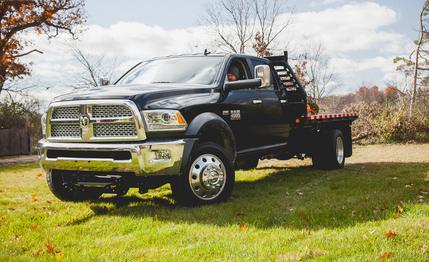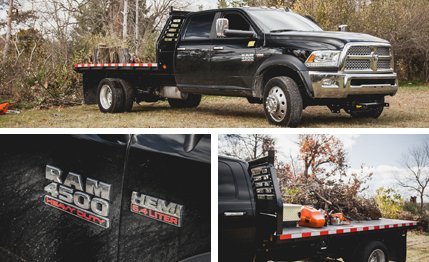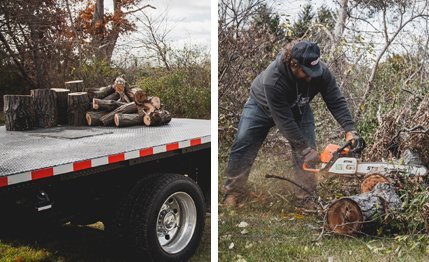 Instrumented Test
Instrumented Test
There’s no better way to evaluate a van or a truck than to, you know, actually use the thing in the manner for which it was designed. So when this author recently decided to spend a few days doing some heavy lifting around the house, we determined it a good opportunity to conduct just such an assessment.
We initially wanted to test a bare-bones, long-box, regular-cab version of the current Ram pickup—almost every example that comes through this place is loaded to the gills—but we quickly learned that no such vehicle existed in Chrysler’s press fleet. Then we received an email containing the question, “Would a 4500 chassis cab with a flatbed work?” This was the equivalent of telling a kid, “There were no more Hot Wheels dump trucks at the toy store, so we got you a real backhoe for your birthday.” So much overkill. So much excitement.
When the truck was delivered to our office, we couldn’t find it. We had the keys in our hand. We had the paperwork authorizing its use. Legally speaking, the truck was clearly in our possession, but it wasn’t in any of our usual parking locations. No, it was parked way off behind our building, next to the dumpster, because a Ram 4500 will not fit in a normal parking spot. It had to be parked perpendicular across four, maybe five, spots. Was 4500 at least 3000 more than we needed? Absolutely.

But there it was: four doors, 11 feet of flatbed, and nearly 200 inches of gluttonous, outrageous wheelbase. When the 4x4 Crew Cab is built, it doesn’t have a flatbed—or any bed at all. It’s up to the buyer to install whatever they want, be it a utility box, a dump bed, or whatever. So if you’re looking to purchase a truck like this, budget at least $3500 for the most basic 11-foot flatbed like the one seen here. Our test truck was a long-wheelbase version in the top-spec Laramie trim and packing the Hemi V-8. (A Cummins turbo-diesel is available.)
While we had the truck, we set it to work dragging a rather large, 36-inch-diameter tree from a brushy area, as well as making a few runs to Lowe’s to grab insulation and sheetrock. We learned that Lowe’s opens at six in the morning on Saturdays, which will come in handy again probably never. We also learned that the only other people haunting the parking lot at that hour are those paid to do so, mostly professional contractors. Their gazes showed envy, even when we attempted to maneuver the truck, with its 55.7-foot turning diameter, through the busy lumber-pickup area.
Driving this monster through a city isn’t as intimidating as it would seem. The extralong wheelbase and rather slow steering (3.7 turns lock-to-lock) provide a good sense of straight-ahead with very little wandering in one’s lane. A zero-to-60-mph trip takes 12.4 seconds, and once the truck gets going, it requires a lot of room to slow its roll: A panic stop from 70 mph requires well more than 200 feet. If you’ve loaded the bed to its 8640-pound payload capacity (including the flatbed), that number will grow substantially. For the record, the truck you see here will tow 15,950 pounds, while the stoutest 4500 (with the diesel) can tug 24,650 pounds.

A 370-hp 6.4-liter V-8 has plenty of power to keep pace with 75-mph traffic, but don’t expect the fuel-economy angels to trumpet your praises: We averaged 8 mpg. That may be just 3 mpg fewer than we achieved with a Ram 2500 with the Hemi, but those 3 measly mpg represent a whopping 38 percent improvement. So you probably want your own fuel account, especially if your truck, like ours, has dual, self-leveling tanks. With a 22-gallon tank augmented by a monster, 52-gallon unit, expect to drop a couple of Benjamins per fill-up.
As for the tasks we set our truck to, asking the 4500 to drag a stump is akin to asking Shaq to get something off the top shelf. The 6.4-liter’s 429 lb-ft of torque, combined with the truck’s nearly five-ton mass, four-wheel-drive system, and 2.64:1 low-range transfer case, mean there’s more than enough traction and muscle to yank a tree from the woods; we could have pulled down Neuschwanstein Castle. Indeed, the truck did its work with our foot riding the brake, since idling was deemed too quick. It was also a gentle brute, as there wasn’t a hint of rut-producing wheelspin.
The classic “Yes, this is my truck. No, I will not help you move” bumper sticker doesn’t seem snotty enough for this one. “Yes, this is my truck. Yours is cute” is more in line, but if you have to put something like this to work, it begins to seem less ludicrous. Speaking of ludicrous, there’s also a 5500 model. Maybe we’ll see about testing one next year when we build our pole barn.